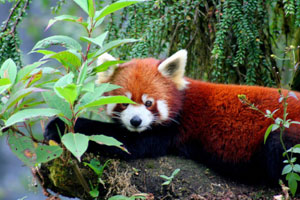|
|
|
Flora and Fauna in Sikkim |
|
|
|
Flora and Fauna in Sikkim
Due to the altitude that varies from sea level to summits that
touch the skies, the flora and fauna naturally covers a wide
spectrum. Nowhere in the world in such a small area can one
find flora and fauna of all varieties - Tropical to the
Alpines. Sikkim's botanical and zoological richness is
awe-inspiring, boasting of more than 4000 species of plants
and 30% of all the birds found in the Indian sub-continent. No
wonder Sikkim has been a dream of naturalists. Dr. J. Hooker
during the middle of the last century surveyed in the detail
the botanical wealth in Sikkim and his findings were embodied
in the 'Himalayan Journal'. |
|
|
|
Flora in Sikkim
Sikkim can be basically divided into three zones. The
tropical from almost sea level to about 5000 feet, the
temperate from 5000 to 11000 feet and the alpine above
11000 feet. Till 10000 feet, there are terraced
farmlands in which the rice, maize, barley and millet
are grown. Cardamoms, oranges, apples, potatoes and
ginger are grown in abundance in the state. The lower
altitudes towards the south harbour jungle cats,
Mongoose, House sparrows. The jungles in the south, are
teeming with plantains, bamboos, tree ferns, walnut, sal
and oak. Orchids also abound in areas with moderate
altitudes. They are the pride of Sikkim and are about
600 species. They come in a wide variety of colours and
sizes. The most popular |
 |
|
|
orchids of
Sikkim are Cymbidiums, Vanda, Cattaleya, Hookeriana, Farmeri,
Dendrobium Amoenum. The Nobile Orchid has been declared as the
State Flower of Sikkim. In the temperate zone, the fauna
comprises of Common Langur, Leopard Cat, Red Panda, Musk deer,
Himalayan Black Bear and the Flying Squirrel. The flora
consist of oak, chestnut, maple, birch, alder, magnolia and
silver fir. In the arid cold alpine regions of Sikkim, roam
the snow leopard and wild ass. There are about 35 species of
Rhododendrons in Sikkim and are found above the height of
10000 feet. The Rhododendron Nivale grows barely a few inches
above the ground. When Rhododendron flower between the month
of April and May, it is a sight to behold with hillsides
becoming shrouded in colour. The variety Rhododendron niveum
has been declared as the State Tree of Sikkim. At the treeless
altitudes above 14000 feet curious types of flowers in colours
of blue, red, violet blossom during summers just a few inches
above the ground. The stones and rocks also get coloured by
lichens and mosses in amorphous pattern.
Fauna in Sikkim
The diversity in the plant world is complemented by a similar
variety in the animal kingdom. Amongst the mammals of Sikkim
are the rare Snow Leopard, Himalayan Black Bear, Red panda,
Musk Deer and Blue Sheep.
Shapi
Shapi is a rare animal that inhabits the alpine region is the
Shapi. It was discovered only in 1938 by a German doctor
Ernest Schalfer. The Shapi has the size of a mountain goat and
has a long white mane. The Shapi is an endangered animal which
is on the verge of becoming extinct. |
|
|
|
Yaks
Among the more commonly found animals in the alpine zone
are yaks. Yaks belong to the cattle family and can
survive only at altitudes above 10000 feet. They survive
on alpine shrubs and can go without food for days
together. Due to the long and thick hair that grows on
its flanks, legs and tail and its thick hide, yaks can
comfortably sleep and rest in the snow. Yaks forage on
their own and do not require grooming, stabling and care
as required by other domesticated animals. Yaks have
been domesticated in Sikkim and are used as beasts of
burden as well as for their meat and milk which |
 |
|
|
though produced in small
quantities is very thick. Yak milk is extensively used for
preparing Churpi which is hardened cheese. The hide and hair
is used for making crude canvas, tents, carpets and blankets.
Crossbreeds of yaks with cows are known as Dzo and these can
survive at lower altitudes.
Birds, butterflies and fishes
Over 400 varieties of butterflies and moths adorn the forest
with colour and life. Giant Lammergeier Vultures, Bearded
Vulture, Eagle, Whistling Thursh, Minivet, Bulbul and Pheasant
are some from among the 550 species of birds recorded in
Sikkim, some of which have been declared endangered. Some
other coloured birds are the emeral dove, fairy blue bird,
kingfisher, ashy woodpecker, sultan tit and the emerald cuckoo.
Many migratory birds like the Ruddy Shelduck also visit Sikkim.
There are also a wide variety of pheasants in various colours.
Blood Pheasant is declared as the State Bird of Sikkim.
Various types of fishes are also found in the lakes and rivers
of Sikkim. There are 45 species of fish in sikkim which
include the trout, salmon and carp. Fishing is allowed with a
permit. There are 40 species of reptiles which include various
types of lizards, snakes, krait and cobra. |
|
|
|
Red
Panda
Among the more exotic mammals is the Red Panda which
lives mostly on treetops. It is found at altitudes
ranging from 6,000 to 12,000 feet. It has been declared
as the State Animal of Sikkim. It is about 2 feet in
length when full grown and belongs to the racoon family.
It feeds mostly on bamboo leaves.
Himalayan Bear
These are found roaming in the temperate forest of
Sikkim. They feed on corn, wild plants, honey and can
sometime grow to enormous sizes. |
 |
|
|
Snow Leopard
The snow leopard is an almost mythical animal. It has rarely
been sighted and to date, only two field zoologists have
succeeded in photographing this elusive animal in its habitat
which can vary from 5,000 feet to as high as 18,000 feet.
More.... |
|